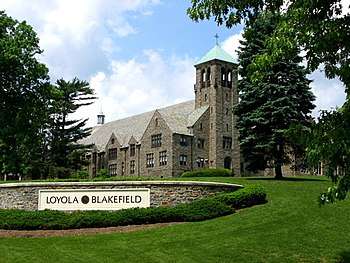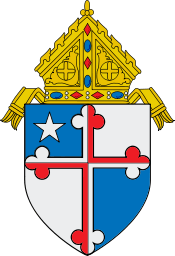Loyola Blakefield
| Loyola Blakefield | |
|---|---|
 | |
| Address | |
|
500 Chestnut Avenue, Towson Baltimore County, Maryland 21204-3704 United States | |
| Coordinates | 39°24′13″N 76°37′36″W / 39.40361°N 76.62667°WCoordinates: 39°24′13″N 76°37′36″W / 39.40361°N 76.62667°W |
| Information | |
| Type | Private |
| Motto |
Ad Majorem Dei Gloriam[1] (For the Greater Glory of God) |
| Religious affiliation(s) |
Roman Catholic (Jesuit) |
| Established | 1852 |
| Founder | Rev. John Early, S.J. |
| CEEB code | 211030 |
| President | Anthony Day |
| Principal | John Marinacci |
| Chaplain | Joseph Michini, S.J. |
| Faculty | 150 |
| Grades | 6–12 |
| Gender | Male |
| Enrollment | 1,000 |
| Average class size | 18 |
| Campus size | 60 acres |
| Campus type | suburban |
| Color(s) | Blue and Gold |
| Slogan | "Roll Dons, Roll" |
| Song | Loyola Alma Mater |
| Fight song | "Come On You Dons to the Fight" |
| Athletics conference | MIAA |
| Sports | Lacrosse, soccer, football, wrestling, water polo, swimming, squash, tennis, ice-hockey, basketball, volleyball, cross-country, indoor track, track & field, golf, rugby, baseball |
| Mascot | The Loyola Don |
| Nickname | Dons |
| Rival | Calvert Hall |
| Accreditation | AIMS |
| Average SAT scores | 1950 |
| Average ACT scores | 28 |
| Publication | The Blakefield Magazine |
| Newspaper | The Loyolan |
| Yearbook | The Loyola |
| Endowment | $25,000,000 |
| Tuition | $20,500 |
| Affiliation |
Archdiocese of Baltimore JSEA |
| Dean of Students | Bob Schlichtig |
| Athletic Director | Brant Hall |
| Website | loyolablakefield |
 | |
Loyola Blakefield, formerly Loyola High School, is a Catholic, college preparatory school for boys established by the Society of Jesus. It is located in Towson, Maryland, within the Archdiocese of Baltimore. Students from Baltimore, Baltimore County, Harford County, Carroll County, Howard County, Anne Arundel County, and Southern Pennsylvania attend the school. It enrolls over nine hundred students in grades six through twelve.
History
Archbishop Francis Kenrick asked the Jesuits to oversee the formation of a school for laymen that would incorporate the Jesuit standards of excellence and build new men conscious of a religious purpose. His request was prompted by the 1852 closure of nearby St. Mary's College. Construction of Loyola High School began on Charles Street in Baltimore, Maryland, in early 1852, and on September 15, 1852, the school enrolled its first students.
In the early 1930s the growing and cramped high school began to look toward moving north of the city. In 1933, with the support of the Blake family, Loyola purchased the land known today as Blakefield in Towson, Maryland. In 1941, the students moved to the new campus. Between 1981 and 1988, a Middle School was gradually introduced, and in recognition of the two levels of education, Loyola High School officially became known as Loyola Blakefield.
Physical improvements in recent years have included the construction of Knott Hall which houses the student commons and dining hall, athletic center, and alumni areas, Burk Hall academic wing, renovations to the 60-year-old science laboratories, and construction of an additional section to Wheeler Hall.
Loyola Blakefield has a tradition of honoring alumni from 50 years earlier at its graduation ceremony. "Bring back the men from 50 years before to see a new generation graduate," writes James Maliszewski, whose grandfather died a year before they could have attended together as 1937 and 1987 graduates.[2]
Academics
Among high schools in the Baltimore area, Loyola Blakefield is highest-ranked in terms of its average graduating SAT scores, annual number of National Merit Finalists, passing AP exams taken, and numerous additional metrics of achievement. Loyola's students frequently attend leading universities in the United States including all institutions belonging to the Ivy League as well as Stanford. Past alumni have received prestigious honors such as the Rhodes Scholarship, Fulbright Scholarship, and Truman Scholarship.
While the central curriculum emphasizing liberal arts and holistic development is standard for all students, there is increasing flexibility in course selection as students move from the sixth through twelfth grades. Some extremely popular electives include visual arts, classical languages, history of music, and a wide variety of AP courses.
The Loyola Forensics team, led by English instructor Tom Durkin and later by science teacher Charles Donovan, was the champion of the National Catholic Forensic League in 2005 and 2010. It has also been very successful at the state and district levels, capturing most of the state titles for two decades and the Chesapeake District title in 2011.
Athletics
Loyola Blakefield competes in the Maryland Interscholastic Athletic Association (MIAA) for all interscholastic sports except for football where they are independent; in addition to the MIAA, the basketball team is also a member of the Baltimore Catholic League.
The Loyola Blakefield football team also plays every Thanksgiving Day in one of the oldest continual national Catholic high school football rivalries, against cross-town rival Calvert Hall College. The game, known as the Turkey Bowl, is held at M&T Bank Stadium in Baltimore and broadcast on television and radio by WMAR-TV.
The Loyola lacrosse program is among its most successful. It won eight championships in the 1980s and also won championships in 2001, 2007, 2008, and 2013. In 2007, they defeated Boys' Latin 10-6 in the MIAA championship game. In 2008, they defeated previously undefeated Gilman 12-11 in the championship game at Towson University's Johnny Unitas Stadium before over 8,000 spectators. Loyola has produced numerous players who have continued on to play collegiate lacrosse, including National Lacrosse Hall of Famer John Stewart, and Peter Kimmel.
Loyola's swimming and diving team has also achieved remarkable successes, having recorded a record run of 20 Maryland Interscholastic Athletic Association state titles in 21 years and six National Catholic Swimming Championships crowns, whilst consistently being ranked within the National Interscholastic Swim Coaches Association national Top-25 Poll for best high school swimming teams.[3]
The soccer program won the Maryland Championship in 2001, 2012, and 2014 and has produced Division I talent. Coach Lee Tschantret, a former longtime player in the Major Indoor Soccer League, won several championships with the Baltimore Blast.
The Loyola basketball program reached regional prominence in the 1970s when it was led by head coach Jerry Savage, who won over 600 games from 1969 to 2003. He produced several Division I players. Savage also coached the 1997 MIAA Championship team, the last championship of any sort for the Dons basketball program. Loyola has been in the most Baltimore Catholic League finals with 13 total and 6 championships. More recently, the program had several disappointing seasons and experienced a four-year period with four different head coaches. Since then Josh Davalli, an All-Metro player at Cardinal Gibbons in the mid-90's, served as varsity head coach while also teaching in the Middle School.
The Loyola Cross country program has had much success, being the first and only team in the MIAA to complete the "Three-peat", then continuing to win six consecutive individual and team titles at the Maryland Interscholastic Athletic Association championship meet. Under the coaching of Jose Albornoz, the Dons have won 14 MIAA/MSA championships to bring the program's total championships to 15 since its inception.[4]
Loyola was MIAA champions in rugby for three consecutive years from 2008 to 2010, and also in 2013 and 2015.[5]
Notable alumni
- Ephraim Francis Baldwin, architect for B&O Railroad
- Tom Callahan, former senior writer for Time magazine and columnist for The Washington Post.
- Jason La Canfora, NFL Network analyst
- Tom Clancy, author
- George Coyne, renowned astronomer and Director of the Vatican Observatory
- J. Joseph Curran, Jr., former Attorney General of Maryland
- Thomas L. J. D'Alesandro III, former Mayor of Baltimore and brother of Nancy Pelosi, Minority Leader of the United States House of Representatives
- Nathaniel Fick, former USMC captain and author of One Bullet Away: The Making of a Marine Officer
- Akira Fitzgerald, North American Soccer League player
- Terence Garvin, current National Football League player for the Seattle Seahawks
- Bill Henry, member of the Baltimore City Council
- Brendan Hines, actor in Fox's Lie to Me[6]
- Bradley M. Kuhn, free software activist
- Aaron LaCrate, music producer and fashion designer
- Mike Lookingland, Baltimore Blast soccer player
- Bruce McGonnigal, former National Football League player
- Jim McKay, Emmy-winning Olympic sports caster and host of the Wide World of Sports
- Thomas F. Monteleone, author
- James T. Smith Jr., Maryland Secretary of Transportation
- James Cardinal Stafford, Apostolic Penitentiary, former President of the Pontifical Council for the Laity and former Archbishop of Denver
- Steele Stanwick, University of Virginia lacrosse player, recipient of the Tewaaraton Award
- Carl Stokes, member of the Baltimore City Council
- Bill Stromberg, College Football Hall of Fame wide receiver and CEO of T. Rowe Price
- Bob Williams, former National Football League player
See also
References
- ↑ "President's Message - Loyola Blakefield". Loyolablakefield.org. Retrieved 28 December 2014.
- ↑ James Maliszewski (May 11, 2002). "May. 11th, 2002 journal entry". Archived from the original on July 9, 2014. Retrieved July 6, 2014.
- ↑ https://support.loyolablakefield.org/swimming
- ↑ "Loyola Blakefield | Team Detail". www.loyolablakefield.org. Retrieved 2017-01-05.
- ↑ "Past MIAA Varsity Rugby Champions". Miaasports.net. Retrieved 28 December 2014.
- ↑ "Here's the truth: The new American TV villain is the liar". Baltimore Sun. Retrieved 28 December 2014.
